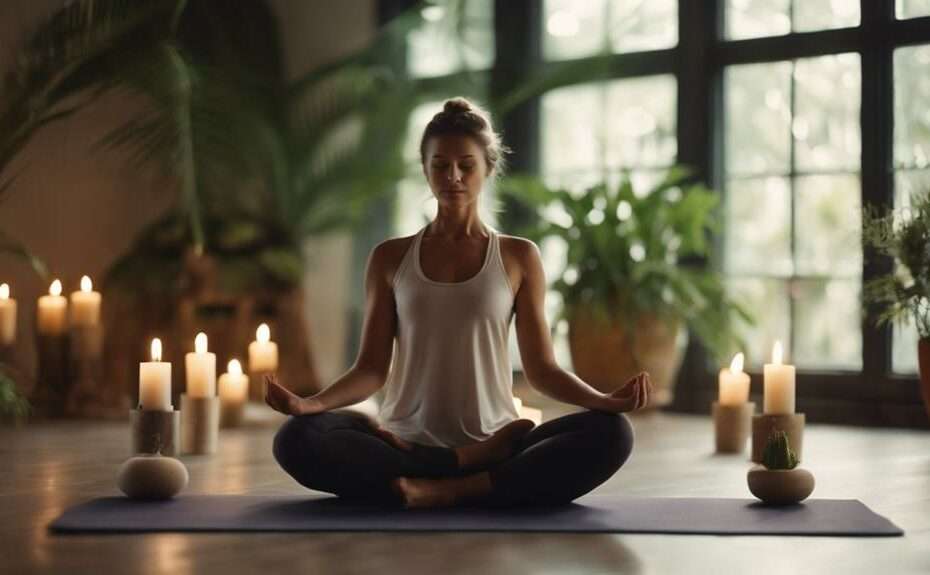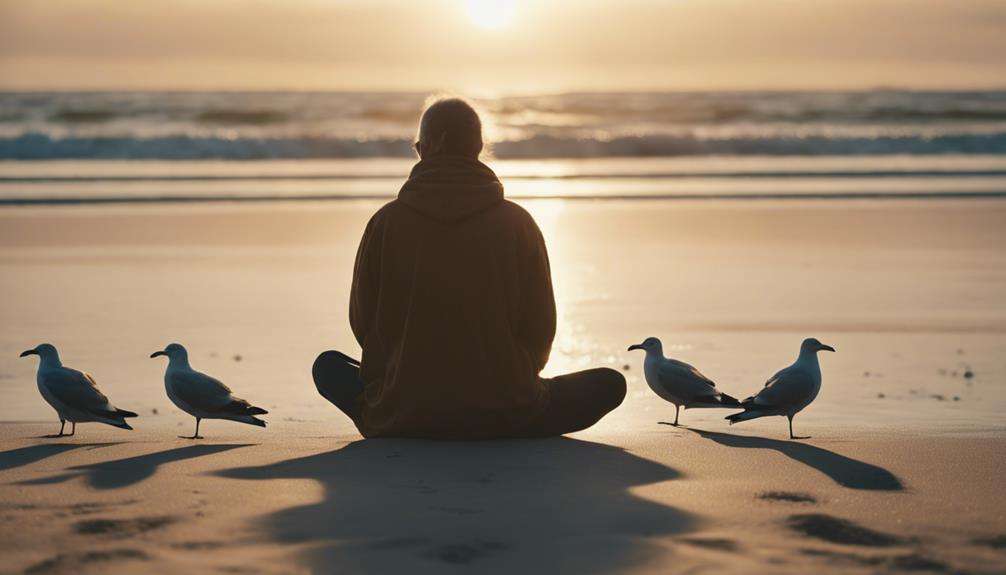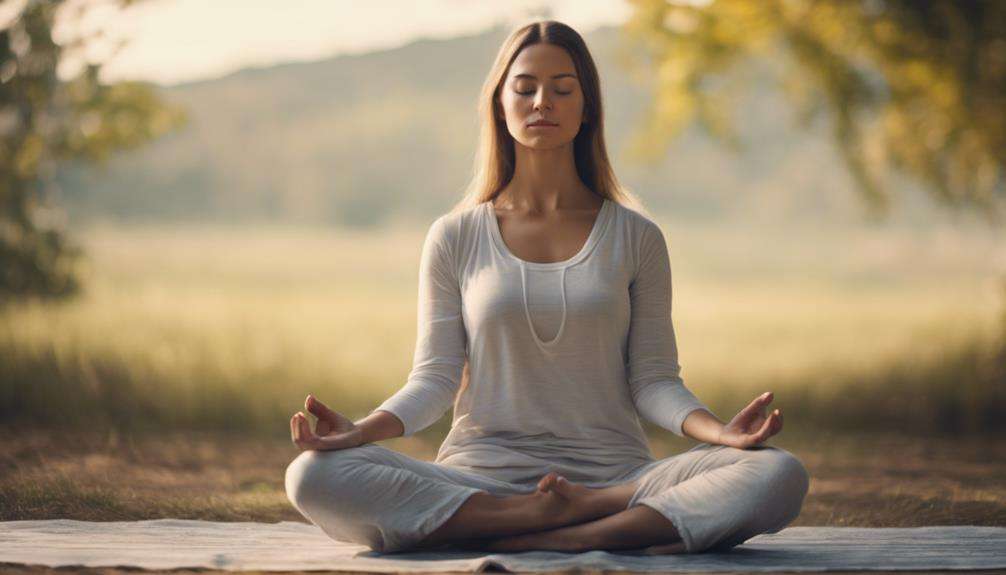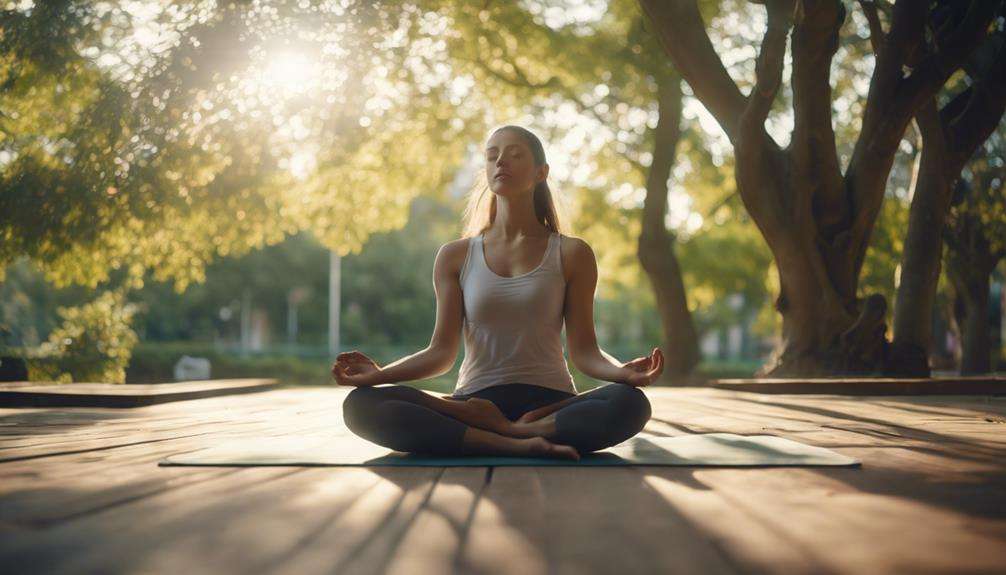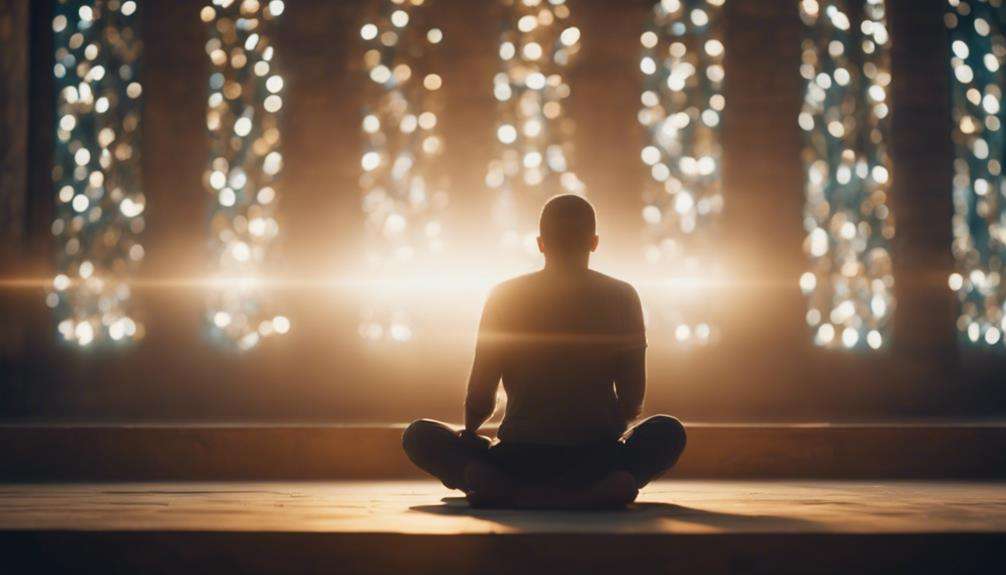Unlock the door to emotional stability with yoga's powerful tools. Delve into the practices that can transform your inner world and cultivate resilience in the face of life's challenges.
By incorporating these 7 best practices, you can discover a path towards greater emotional balance and well-being.
Key Takeaways
- Cultivate emotional balance through mindfulness meditation and gratitude in yoga practice.
- Use breathwork techniques for stress relief and serenity, promoting emotional stability.
- Practice yoga asanas and restorative poses for anxiety management and emotional stability.
- Enhance emotional regulation, self-awareness, and stress reduction with yoga practices.
Mindfulness Meditation for Emotional Balance
Looking to enhance your emotional stability? Consider incorporating mindfulness meditation into your routine for achieving better emotional balance. Mindfulness meditation involves focusing on the present moment without judgment, which can significantly improve emotional regulation and resilience. Research has shown that practicing mindfulness meditation regularly can reduce symptoms of anxiety and depression, helping you manage overwhelming emotions effectively.
By engaging in mindfulness meditation, you can increase self-awareness and develop a deeper acceptance of your emotions. This practice allows you to observe your thoughts and feelings without getting caught up in them, leading to a greater sense of emotional balance and stability in your life. Instead of being consumed by negative emotions, mindfulness meditation empowers you to acknowledge and process your feelings in a healthy way.
Incorporating mindfulness meditation into your daily routine can be a powerful tool for cultivating emotional well-being and overall stability. Give yourself the gift of mindfulness to navigate life's challenges with greater ease and grace.
Breathwork Techniques for Stress Relief
To effectively manage stress and cultivate emotional well-being, exploring specific breathwork techniques like Box Breathing and Kapalbhati Breath can be highly beneficial. Deep breathing, a fundamental aspect of yoga practice, has been shown to slow the heart rate and reduce anxiety effectively.
Box Breathing, where you inhale, hold, exhale, and hold your breath for equal counts, can help regulate emotions and calm the mind. Kapalbhati Breath, a more dynamic breathing technique involving short, forceful exhales and passive inhales, can energize the body and clear the mind, aiding in stress relief.
Tailoring your breathwork practices to match your desired emotional state is crucial for effectively managing stress levels and promoting relaxation. By incorporating these breathwork techniques into your daily routine, you can tap into the power of your breath to regulate your nervous system, reduce stress, and enhance emotional stability.
Yoga Asanas for Anxiety Management
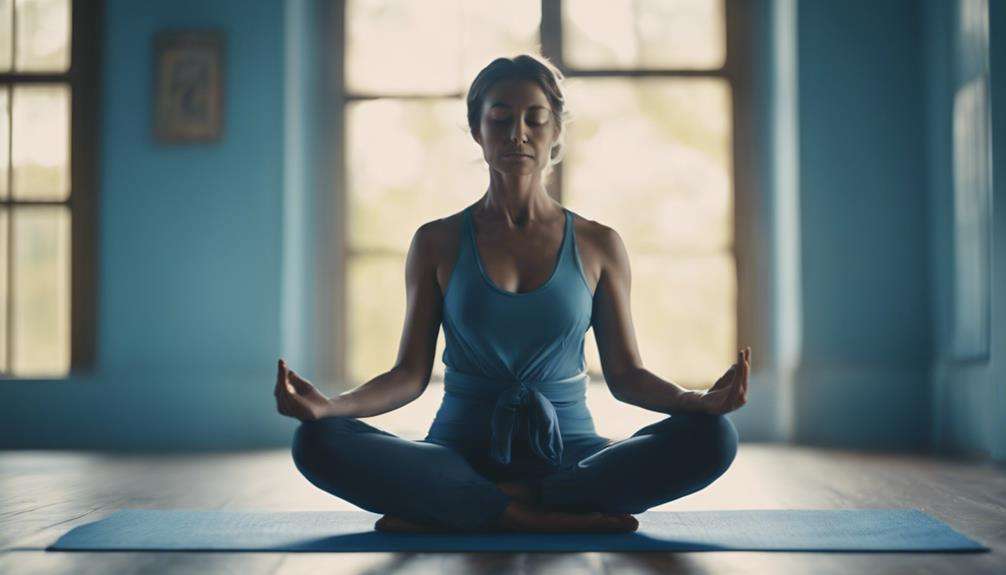
For managing anxiety effectively, incorporating specific yoga asanas like Child's Pose, Legs-Up-the-Wall, and Corpse Pose into your routine can be highly beneficial.
Child's Pose helps in calming the mind, reducing stress, and alleviating anxiety levels. This gentle pose provides a sense of security and allows you to turn inward, promoting relaxation and peace of mind.
Legs-Up-the-Wall pose is excellent for anxiety management as it encourages blood flow back to the heart, calming the nervous system and reducing anxiety symptoms.
By practicing Corpse Pose regularly, you can experience deep relaxation, release tension, and soothe the mind, which aids in managing anxiety effectively.
These yoga asanas, when done consistently, contribute to reducing anxiety levels over time, providing you with a sense of calm and emotional stability. Incorporate these poses into your routine to cultivate a more peaceful and centered state of being.
Cultivating Gratitude Through Yoga Practice
As you explore cultivating gratitude through your yoga practice, you'll discover the transformative power of gratitude journaling, mindful breathing techniques, and heart-opening poses.
These practices can help shift your focus towards the positive aspects of your life, fostering a sense of abundance and contentment in your daily experiences.
Gratitude Journaling Benefits
Cultivating gratitude through yoga practice fosters emotional stability and enhances overall well-being.
Gratitude journaling is a powerful tool that promotes positivity, emotional well-being, and mindfulness. By jotting down things you appreciate, you shift your focus from negatives to positives, fostering resilience and self-reflection.
This practice not only helps you become more aware of the good in your life but also reduces stress levels significantly. Studies have shown that keeping a gratitude journal can improve your mood, boost mental health, and contribute to emotional balance.
Embrace this simple yet impactful practice to cultivate a mindset of appreciation and enhance your overall well-being through the power of gratitude journaling.
Mindful Breathing Practices
By incorporating mindful breathing practices into your yoga routine, you can enhance your sense of gratitude and emotional stability. Mindful breathing, such as Pranayama, focuses on the present moment, fostering inner peace and relaxation. This technique helps reduce stress levels, promoting emotional stability.
Through conscious control of the breath, you can shift your perspective and cultivate a positive mindset, leading to increased emotional resilience. Consistent practice of mindful breathing in yoga not only enhances your emotional well-being but also allows you to experience a deeper sense of gratitude in your daily life.
Embrace these practices to bring about a sense of calm and gratitude, creating a harmonious balance within yourself.
Heart-Opening Yoga Poses
Open your heart to gratitude and emotional stability through the practice of heart-opening yoga poses.
Heart-opening poses like Camel Pose (Ustrasana) can help release pent-up emotions by expanding the chest and activating the heart chakra. These poses encourage vulnerability and trust, fostering emotional stability and inner peace.
By stretching the front body, you can experience a deep emotional release and cultivate a sense of gratitude towards yourself and others. Embracing chest expansion in your practice not only opens your physical body but also your heart to new possibilities.
Through heart-opening yoga poses, you can build a stronger connection with your emotions, leading to a more stable and peaceful state of mind.
Emotional Release Through Yoga Flow
Flowing gracefully through yoga poses can be a powerful method to release pent-up emotions stored in your body. Engaging in a yoga flow sequence, especially movements like sun salutations, can help facilitate emotional release and catharsis. Here are some ways a yoga flow can aid in emotional release:
- Dynamic Movements: The dynamic nature of a yoga flow can assist in letting go of emotional tension and stress.
- Breath Work Integration: By combining breath work with movement in a yoga flow, you can promote emotional balance and release.
- Mindful Movement: Moving mindfully through a yoga flow allows you to process and release emotional blockages.
- Fluid Transitions: Seamless transitions between poses in a flow sequence can help you flow through and release emotions.
- Energy Flow: The fluidity of a yoga flow can help energy circulate through your body, aiding in emotional release and balance.
Embrace the flow of your practice to release emotional burdens and cultivate emotional stability.
Restorative Yoga for Inner Peace

Are you seeking a tranquil practice to find inner peace?
Restorative Yoga offers calming poses that encourage deep relaxation and breathwork for serenity.
This gentle practice with supportive props can help soothe your mind and body, promoting emotional stability and balance.
Calming Poses for Relaxation
Restorative yoga offers a sanctuary of tranquility and rejuvenation, providing a soothing refuge for the mind and body. Calming poses in restorative yoga are essential for promoting emotional balance and inner peace. These poses not only reduce stress and anxiety levels but also aid in calming the nervous system, fostering emotional stability.
Through passive stretching and gentle support, restorative yoga fosters an environment conducive to relaxation and well-being. Embrace these calming poses to enhance your practice and cultivate a sense of peace within:
- Child's Pose
- Legs-Up-the-Wall Pose
- Supported Bridge Pose
- Reclining Bound Angle Pose
- Corpse Pose
Engage in these poses regularly to experience the profound benefits of restorative yoga.
Breathwork for Serenity
To cultivate inner peace and serenity in restorative yoga, incorporating breathwork is essential for deep relaxation and emotional stability. Deep breathing techniques in restorative yoga play a crucial role in promoting emotional balance and releasing tension in the body.
By focusing on mindful breathing during poses, you can reduce stress and anxiety, allowing for a sense of calm and tranquility to wash over you. This intentional breathwork encourages a state of relaxation, helping to soothe the mind and body.
Through the combination of gentle restorative yoga poses and deep breathing exercises, you can create a nurturing experience that fosters emotional stability and inner peace. Embrace the power of breathwork to find serenity within yourself.
Yoga Nidra for Deep Relaxation
How can Yoga Nidra transform your relaxation experience into a journey of deep inner rejuvenation and peace?
Yoga Nidra is a profound relaxation technique that goes beyond just relieving stress – it can lead you on a path to deep relaxation and self-discovery. Here's how Yoga Nidra can help you achieve emotional stability and mental clarity:
- Guided Meditation: Through a structured practice, you'll be guided into a state of conscious deep sleep, allowing for complete relaxation.
- Stress Reduction: By calming the nervous system, Yoga Nidra helps alleviate stress, anxiety, and insomnia, promoting a sense of peace.
- Self-Awareness: This practice fosters self-awareness, helping you understand your emotions and responses better.
- Emotional Stability: Regular practice of Yoga Nidra can enhance emotional stability, leading to a more balanced inner state.
- Mental Clarity: By promoting relaxation and self-reflection, Yoga Nidra can improve mental clarity and focus in your daily life.
Embark on a journey of deep relaxation and self-discovery with Yoga Nidra to cultivate emotional stability and inner peace.
Frequently Asked Questions
How Yoga Helps in Emotional Stability?
Yoga helps in emotional stability by connecting your mind and body, relieving stress, raising self-awareness, balancing emotions, cultivating inner peace, teaching relaxation techniques, enhancing mental wellness, and boosting emotional resilience. It's a powerful practice for emotional well-being.
Which of the Following Yoga Practices Helps in Emotional Management?
Breathing techniques like Nadi Shodhana and Bhramari pranayama aid in emotional management by fostering a strong mind-body connection. They trigger the relaxation response, offering stress relief, enhancing emotional resilience, self-awareness, mindfulness practice, and mood regulation.
How Does Yoga Help With Emotional Regulation?
Yoga helps with emotional regulation through breath control, fostering a mind-body connection. It reduces stress, enhances self-awareness, promotes emotional release, improves moods, and offers relaxation techniques for mental clarity. Embrace yoga for stability in your emotions.
How Do You Release Trapped Emotions With Yoga?
When releasing trapped emotions with yoga, you focus on breathwork techniques, connect mind and body, balance energy flow, release trauma, balance chakras, practice grounding exercises, release emotions, and engage in meditation for emotional stability.
Conclusion
Congratulations on taking the first step towards emotional stability through yoga! You're now equipped with powerful tools to navigate life's challenges with grace and resilience. Your practice will lead you to a state of calm, clarity, and peace like never before.
Embrace the journey ahead with confidence and trust in the transformative power of yoga. Your emotional well-being is worth every moment on the mat. Keep breathing, moving, and growing towards a more stable and fulfilling life.
Namaste.
